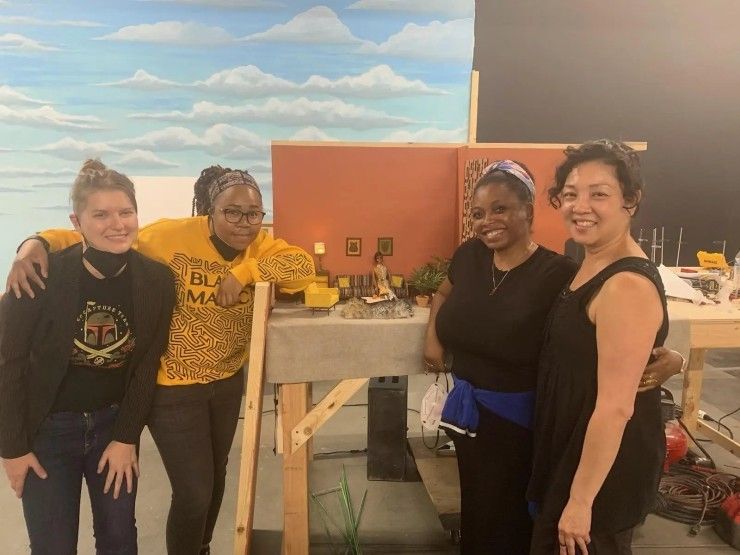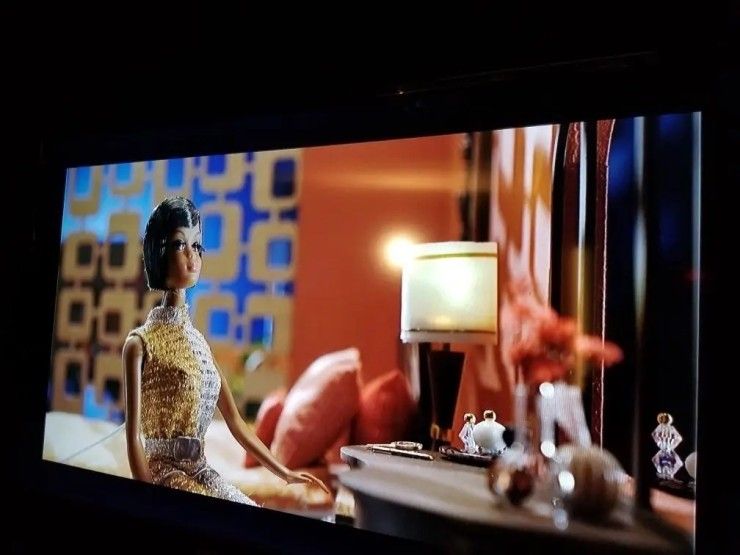
The first Black fashion doll to take on the Barbie name was released in 1980. Now, 43 years later, director, writer, and producer Lagueria Davis, is telling the story of the first Black Barbie in a documentary to explore the intergenerational impact this doll has had on Black women.
This post was written by Meagan Keane and originally appeared on Adobe blog on Mar. 10, 2023.
It all started with a seemingly simple question from the filmmaker’s 84-year old aunt, Beulah Mae Mitchell, who asked, “Why not make a Barbie that looks like me?”
Black Barbie: A Documentary gives a voice to the insights and experiences of Mitchell who spent 45-years working at the toy company, Mattel, and discusses how the absence of Black images in the “social mirror” left Black girls with little other than white subjects for self-reflection and self-projection. Mitchell and other Black women in the film talk about their own, complex, varied experience of not seeing themselves represented, and how Black Barbie’s transformative arrival affected them personally.
To build this film, editor Heidi Zimmerman and her team had a wide range of footage to organize including multicam interviews, verite with Beulah Mae, staged Barbie dolls scenes, product shots, and archival footage. With the help of Productions in Premiere Pro, and Frame.io, Zimmerman was able to organize all the shots and stay on track.
Black Barbie: A Documentary will premiere at SXSW Saturday, March 11th. Read on to see how editor Heidi Zimmerman helped bring Black Barbie: A Documentary to the big screen.
How and where did you first learn to edit?
I first learned to edit in high school. My high school had a video tech lab with an old tape to tape editing system that you’d typically find in local news stations at the time. It was linear editing, so you’d set in and out points on your source and lay it down on the final tape shot by shot. You could insert only video or only audio by doing an insert edit but reworking your work was pretty limited. It was a different way of thinking — you’d structure your ideas out on paper, lay down a good base with A-roll, and then insert your B-roll on top. If you made a change, you were more likely to commit to it because there was no undo button.
How do you begin a project/set up your workspace?
Organization is key. I tend to organize the project of every doc the same way, so that I’m not navigating a new organizational system as I’m learning the new material. I want to emotionally experience the footage and not get slowed down by the technical. All the production footage is pulled in and organized in bins by date, which lives in its own folder called Camera Masters. Then I’ll string out the material by location or by interview in sequences, which lives in a new folder called Dailies Stringouts. I use a pancake editing technique, so I rarely go back to those bins with individual shots, and instead, mark-up and work with these stringouts. We had a lot of different types of footage in this film: multicam interviews, verite with Beulah Mae, staged Barbie dolls scenes, product shots, archival, and this material was shot with a variety of cameras. Using a standard, neutral organizational system not only helped me find everything but also helped me see and experience the footage for what it is.
Credit: Black Barbie: A Documentary
Tell us about a favorite scene or moment from this project and why it stands out to you.
I love that Lagueria wanted to capture all aspects of the Barbieverse, so she interviewed a lot of Black Barbie collectors. One of my favorite scenes is a character capsule on a collector named Byronique Barbie. Byronique has embodied Black Barbie in her own unique way and modeled her life after her. Her take on the Barbie persona makes a lot of sense when you reflect on Barbie throughout the years. Her perspective surprised and enlightened me. I thought it was amazing that a doll could shift someone’s life in such a profound and positive way. It really speaks to the power of representation.
What were some specific post-production challenges you faced that were unique to your project? How did you go about solving them?
In Black Barbie: A Documentary, Lagueria shot scenes using puppeted Barbie dolls, and all those shots had to be sent to VFX to clean-up wires and what not. Most docs don’t have VFX, so this was a new challenge for me. I was looking for a quick automated way to create VFX pulls, rather than one by one. We used consolidate and transcode in the Project Manager to create the pulls with handles while maintaining the timecode.
What Adobe tools did you use on this project and why did you originally choose them? Why were they the best choice for this project?
Both Lagueria and our producer, Aaliyah are based in LA, and I’m based in Portland, Oregon, so we knew that we’d need the right tools to work together remotely. We used Premiere Productions to edit and Frame.io to review and collaborate. My assistant, Jayda Cardoza, and I wanted to be able to share the project and work on the film at the same time without having to swap project files, import sequences, or create duplicate clips. Neither one of us had ever used Productions before, but we decided to take the leap and it turned out to be a great choice. If you’ve ever cut anything long form on Premiere Pro, you’ll know that the project file can get pretty large pretty fast as you create more sequences, which can bog you down. I used to duplicate my project file every week keeping only the latest sequences of the cut in it to keep the project file small. With Productions, all my cuts lived in the Production in different project files, which you can really think of as bins. We hosted the Production folder on Lucidlink and had identical drives of the media locally. There was no relinking, duplicate clips, or passing of sequences. Everything was easy to access by both of us very quickly.
Lagueria and I used Frame.io daily to swap ideas and cuts. I like that it’s integrated into Premiere Pro. I could see and respond to Lagueria’s comments directly inside a Premiere Pro panel. When it came time for graphics and VFX, being able to draw comments on the picture really helped our team communicate creatively. Frame.io is also faster at posting material than other review platforms.

Credit: Black Barbie: A Documentary
What do you like about Premiere Pro, or any of the other tools you used?
There’s a lot to like about Premiere Pro — it’s pretty intuitive and easy to maintain. I like that I can have multiple versions on my computer at the same time because sometimes clients aren’t ready to upgrade for whatever reason, and if I’m bouncing between clients, I don’t have to worry about messing up their workflow because my software isn’t compatible.
What’s your best Premiere Pro tip to share?
I think the most underrated gem of Premiere Pro is the text panel, which can transcribe and caption sequences. With the footage already laid out in sequences for pancake editing, I use the text panel to create transcripts for all the dailies. It works in the background, can be done in a few minutes to a few hours depending on the length of the interview, and you don’t need to send material out of the house. These transcripts are searchable and linked to the sequence, so if you need to find a replacement word or a concept you can do so very quickly. It’s AI, so it’s not perfect, but it’s very easy to correct.
Who is your creative inspiration and why?
Tough question! Recently, I’ve been drawing a lot of creative inspiration from documentary filmmakers that I see on the film festival circuit. The pandemic pushed a lot of film festivals online, making them more accessible than ever. It’s inspiring to hear the challenges these doc filmmakers face and how they solved them. They are working with some of the same constraints we’re all working with in the independent world.

Credit: Black Barbie: A Documentary
What’s the toughest thing you’ve had to face in your career and how did you overcome it? What advice do you have for aspiring filmmakers or content creators?
Another big question! When I think about some of the toughest things I’ve had to face in my career, it usually boils down to a breach of personal boundaries. This industry is full of creative, passionate people determined to create and succeed. Because of that, you may be asked to do things that in your gut don’t feel right, safe, or fair, and may not be something you want to do. Sometimes an uneven power dynamic and the fear of unemployment may make you feel obligated to do certain things or tolerate certain conditions. Trust your gut and your instincts, don’t silence your own voice, and hold on to your personal boundaries as best as you can. Easier said than done, especially earlier in your career when you are trying to break in or pay your dues. My best advice is to stay as grounded as you can with friends, especially those not in the industry, so that you can keep a broader perspective in mind.

Credit: Editor Heidi Zimmerman
Share a photo of where you work. What’s your favorite thing about your workspace and why?
I have a dedicated office in the basement of my house. A few years back, my husband printed out and framed the movie poster from one of my favorite projects as a holiday gift. Now, I have a few posters of my films hanging on my office walls. I love them, they remind me of what I’ve accomplished and feel like old friends. When I’m in the middle of a project, and I feel like there are a thousand directions it could go and that nothing is working, it’s good to look back over my shoulder for that positive affirmation.














